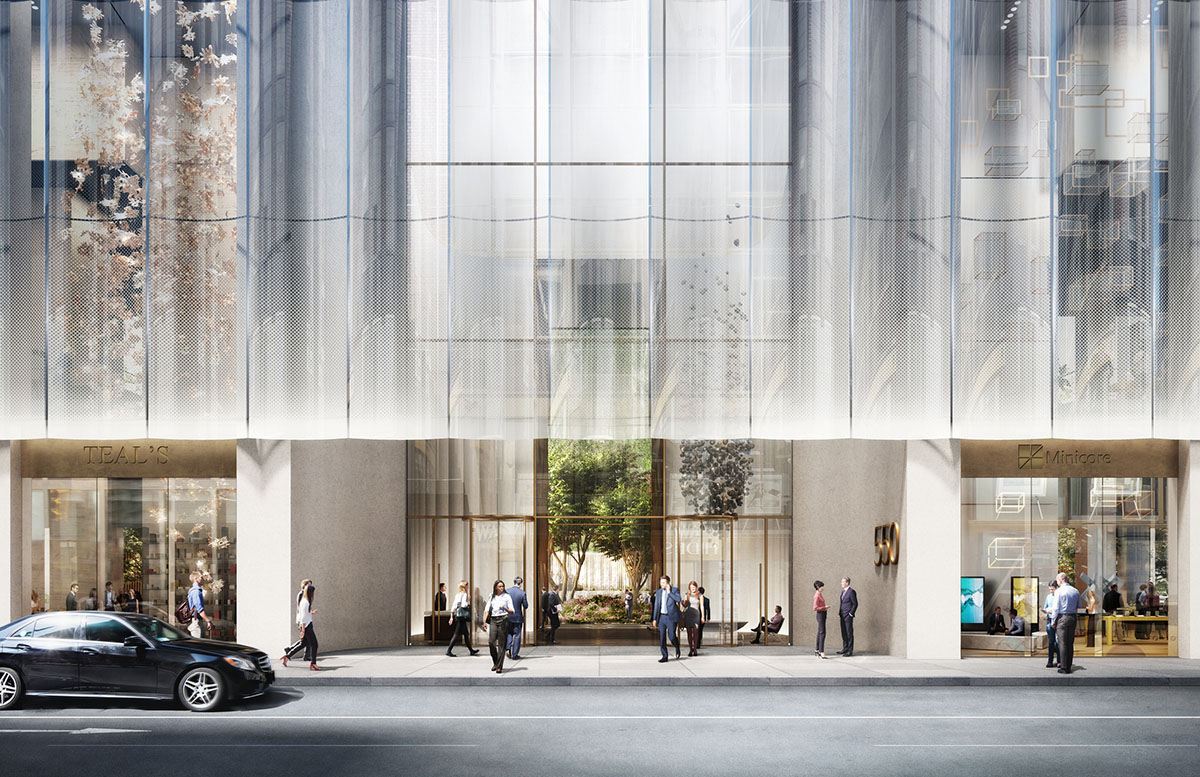Submitted by WA Contents
Snøhetta set to overhaul Philip Johnson’s 1980s postmodern tower in New York
United States Architecture News - Nov 02, 2017 - 17:15 18547 views

Norwegian architecture firm Snøhetta has been commissioned to overhaul the 1980’s postmodern tower located at 550 Madison Avenue. Formerly known as the AT&T building, the building is one of iconic postmodern structures of Philip Johnson and designed with John Burgee in 1984.
Snøhetta will redesign the 197-metre tower nearly by doubling the amount of public space while transforming the base of the 1980s tower into a lively, transparent street front - extending the lively activity of Madison Avenue further south to 55th Street.
The studio's reenvision plans comprise the major update on the building with state-of-art systems and bring new life into the building’s public, retail and office spaces for the contemporary needs of one of the world’s most recognized avenues.

Lobby Entrance Detail on Madison Avenue. Image © DBOX
Previously known as the Sony Building, but now known as 550 Madison, the building was originally designed by Philip Johnson for single-tenant occupancy, serving as the eponymous world headquarters for its corporate owners. Since the departure of the Sony Corporation more than a year-and-a-half ago, its office floors have sat vacant.
The studio's redesigns scheme modernises interior spaces to meet the contemporary needs of a variety of office tenants and adds high-quality amenities, world-class retail and restaurants.
"Snøhetta’s design approach stitches the life of the building back into the street. Since 550 Madison was first completed, its fortress-like base created an uninviting street front, which was then further compromised by a series of ground-floor renovations that effectively closed the building off from its surroundings. With the updated design, the stone façade will be partially replaced at eye level by an undulating glass curtain wall," said the firm regarding its design approach.
"From the street, the reconceived façade dramatically highlights the multi-story arched entry while revealing the craftsmanship of the building’s existing steel structure."
"Scalloped glass references the sculpted forms of fluted stone columns, re-interpreting the building’s monumentality while creating a lively and identifiable public face for passersby. With this increased transparency, the activity within the lobby, atrium, and first 2 levels of the building will become part of the vibrant energy of the street," added the studio.

The existing AT&T building. Image © DBOX
The AT&T building is commonly known as the first postmodern skyscraper, expressing itself as "a commercially-well-timed reaction against Miesian modernism and its derivatives" at that times.
As part of the renovation, Snøhetta will convert 550 Madison’s proposed public space into an outdoor garden, providing a verdant landscape with water features and trees as a respite from the dense urban fabric of Manhattan. The studio will also transform the existing mid-block passageway at the rear of the tower connecting 55th and 56th Street into a serene public space.
Snøhetta will remove neighboring annex building to allow access to open air and daylight while nearly doubling the amount of publicly accessible space. The revitalized public garden makes itself visible from the densely-built streetscape with entrances anchored by vegetation, as well as through the reconfigured building lobby as a splash of color that catches the eye.
The renewed 550 Madison aspires to be a leader for commercial tower renovations in the future, targeting LEED Gold for sustainability, WELL-certification for healthy materials and well-being, and WIRED-certification for digital infrastructure. It will employ a Dedicated Outdoor Air Ventilation System (DOAS), ensuring tenants have access to a continuous supply of clean fresh air, while consuming less energy than typical VAV mechanical ventilation systems.
In leading the transformation of East Midtown for the rapid changes of the contemporary workforce, 550 Madison will ensure the area remains a thriving, world-class business district.
"The garden encourages a variety of experiences: to meet over lunch and socialize, to find a moment of peace besides the water feature, or to experience a tactile connection to nature. A sensitively curated planting palette will celebrate the dynamic seasonality of the Northeastern climate, transformed over the course of the year by colorful flowering trees and blubs in spring, warm autumnal colors, and the stark elegance of cypresses and evergreens in winter," added the firm.

After Snøhetta's renovation of the existing AT&T building - 550 Madison Avenue, looking North from 55th Street. Image © DBOX
"These new plantings will allow smaller species of birds and butterflies to flourish in their new environment, a unique urban habitat. The lush outdoor garden will be the largest within a 5-minute walking radius of the building, providing a respite from the verticality of Midtown, awakening people to their surroundings, and allowing them to linger and take pleasure in a part of the city that they typically rush through."
"The re-imagined 550 Madison reflects how we work and live in New York today. The design sensitively transforms a sculpturally monumental building and celebrates the experience of the building where it meets the street. By updating this inward-looking tower for the 21st century, the redesign will foster a more vibrant, dynamic relationship between the building, the city, and the people who inhabit it," explained Snøhetta.
The owner of the tower is a Saudi Arabian company Olayan Group and the budget of the overhaul is expected to cost $300-million.
Philip Johnson is an important figure of modernism and he brought the International Style to America in 1932 with his MoMA exhibition and designed such pure modernist forms as the Glass House in New Canaan, Connecticut is the first irony of this building.
However, Johnson's dramatic changes on his style from modernism to postmodernism started to appear in 1960s - who was conceived as the "new" Philip Johnson. The AT&T building coincides with his dramatic shift at that times and emerges as the second irony.
Top image: 550 Madison Avenue, view looking west at updated façade. Image © DBOX
> via Snøhetta
